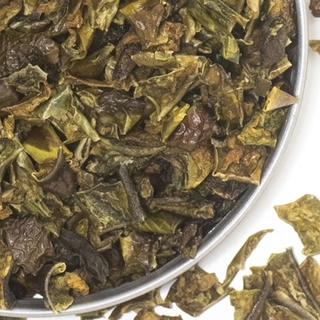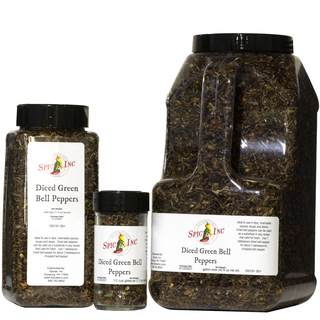Dried Green Bell Peppers




Dried Green Bell Peppers
Dried Green Bell Peppers, Capsicum annuum, are completely mild peppers that measure 0 Scoville Heat Units (SHU). They are technically considered chiles since they are part of the capsicum family. They are also called air-dried green bell peppers, dehydrated green bell peppers or green bell pepper flakes.
The unripened fruit of the bell pepper plant, Dried Green Bell Peppers retain their grassy flavor profile and mild vegetal aroma during dehydration. The flavor condenses when they dry, so they may be more piquant than the average bell pepper. Dried Green Bell Peppers contain a volatile oil content of approximately 3%, though they can go as high as 5% due to their concentration during the dehydration process.
Businesses that frequently purchase Dried Green Bell Peppers are:
- Asian fusion and café style restaurants;
- seasoning companies;
- butchers;
- independent spice shops;
- creameries; and
- companies that manufacture sauces
We also have Granulated Green Bell Pepper, Granulated Red Bell Pepper, and Diced Red Bell Pepper available.
Flavor Profile
Dried Green Bell Peppers have a grassy, brisk flavor and bittersweet finish.
Heat Level
Dried Green Bell Peppers are completely mild and have a rating of 0 Scoville Heat Units.
How To Use
Rehydrate Dried Green Bell Peppers by soaking in hot water for 20 minutes and draining or add to a dish to cook for the final 20 minutes. Or add directly to a dish that’s going to cook for a while and let it rehydrate this product for you. This is a wonderful addition to a mild queso dip and goes wonderfully with instant pot baked beans. Rehydrate for a pepper chicken stir fry, make a great Southwestern omelet, and add Dried Green Bell Peppers to the hash browns, too.
Pair Dried Green Bell Peppers with onion, garlic, coriander, cilantro, thyme, parsley, black beans, cheese, chickpeas, eggplant, eggs, potatoes, and tomato.
Use Dried Green Bell Peppers when making omelets, chicken, beef, pork, or tofu stir fry, tomato sauce, pizza, pasta, potatoes, chili, soup, stew, dips, potatoes, cream sauces, and cheese products.
| Also Called | Air-dried green bell peppers, dehydrated green bell peppers or green bell pepper flakes |
| Species | Capsicum annuum |
| Ingredients | Dried, diced green bell pepper |
| Flavor Profile | Grassy, vegetal, bittersweet |
| Oil content | 3.0-5.0% |
| Scoville Heat Units | 0 SHU |
| Recommended Uses | Stir fry, chili, soup, stew, dips, cheese, cream dishes, potatoes |
| Cuisine | Global |
| How To Store | Airtight container in a cool, dark place |
| Shelf Life | 1-2 years |
| Country of Origin | China |
Nutrition Facts
Serving Size1 tsp
Amount Per Serving
Calories4
% Daily Value*
Total Fat0g0%
Saturated Fat0g0%
Trans Fat0g
Polyunsaturated Fat0g
Monounsaturated Fat0g
Cholesterol0mg0%
Sodium2.0mg0%
Total Carbohydrate0.7g0%
Dietary Fiber0.2g1%
Total Sugars0.4g
Added Sugars0g0%
Sugar Alcohol0.0g
Protein0.2g0%
Vitamin D0mcg0%
Calcium1mg0%
Iron0mg1%
Potassium32mg1%
*The % Daily Value (DV) tells you how much a nutrient in a serving of food contributes to a daily diet. 2,000 calories a day is used for general nutrition advice. These values were calculated and therefore are approximate. For more accuracy, testing is advised.


